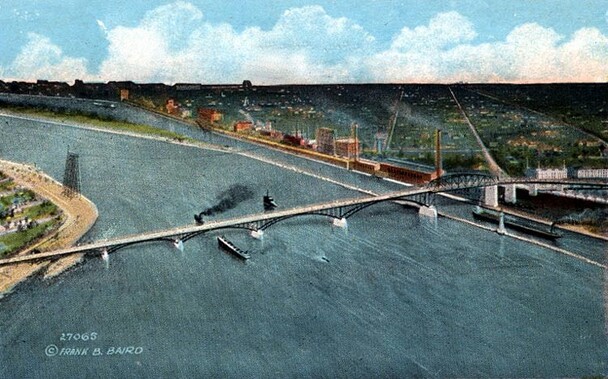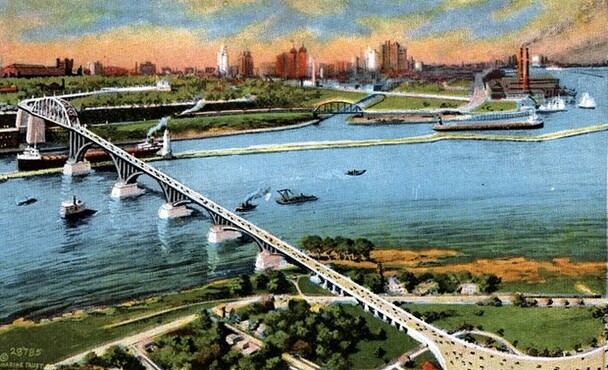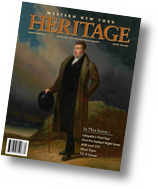(Above) Bird's eye view of the Peace Bridge, c. 1930's. The Parker Truss is visible on the American side at right as it crosses the Black Rock Canal. Note the electric transmission tower at left along the Canadian side. Not clearly visible is the matching tower on the American side. These still exist in 2005.
The idea of a bridge joining Canada and the United States between Buffalo and Fort Erie was discussed as early as 1853. Among the insurmountable problems were the swift current of the Niagara River, the enormous cost that would be involved, and the fact that both Canadian and American laws had to be passed to permit the bridging to occur.
Alonzo Mather, an American born in Fairfield, NY, believed that a bridge should be built. He invested much of his fortune from the Union Stockyards Bank (Buffalo) in purchasing lands on the Canadian and American shores, at the places where the Peace bridge terminals now stand. But a NYS Senator, Thomas Platt, was so opposed to this idea that he succeeded in having a federal law passed that stipulated no international bridges could be built without an act of Congress.
By 1913, others had taken up the cause to build a bridge for vehicular traffic between Buffalo and Fort Erie. World War I interrupted what quickly became a very popular clamor for a bridge, and in 1919 the American West Side Businessmen's Association and the Canadian area businessmen started again to push for a bridge. They succeeded in having the Buffalo and Fort Erie Bridge Commission approved by the several legislatures.
The agreement that resulted was that private investors would construct the bridge and recoup their investment through tolls until the bonds were retired, and then the bridge would become the property of the State of New York and the Dominion of Canada. Construction began in 1925 and the "Peace Bridge" was opened to the public June 1, 1927. Alonzo Mather died in 1941 and Mather Park on the Fort Erie side of the Bridge (right side of bridge approach above) was named after him.
The Peace Bridge suffered financially during the Depression and appealed to state and federal legislative bodies for tax relief. Such relief was granted but to ensure its survival, a public benefit corporation, or Authority, was created by New York State. The federal laws further required that this be approved and, in 1934, President Franklin Roosevelt signed legislation that finalized the creation of the Buffalo & Fort Erie Public Bridge Authority.
In the mid-1960's, traffic on the Peace Bridge had increased such that a discussion arose as to whether the Peace Bridge capacity needed to be expanded and, if so, in what way. The October 1967 report recommended widening of the existing structure to five or six lanes. Widening was preferred to other options because of the cost associated with building new facilities, land acquisition and additional construction cost to duplicate piers, plus plaza construction.
Though some remedial work on bridge piers, etc. was completed by the early 1970s, traffic had leveled off by 1972, and so the Authority decided not to proceed with the widening. A follow-up study in 1973 concluded that the widening project was financially impractical, as well as unnecessary due to the attached predictions relative to future traffic. Thus the Authority decided to postpone the Bridge widening. Their position was reviewed annually, but did not result in a change of plans.
In 1999, after a 7-year study, the Buffalo and Fort Erie Public Bridge Authority determined to construct a "companion" bridge adjacent to the Peace Bridge. Public passions were immediately engaged, the City of Buffalo refused to grant the necessary land easements, and the project was put on hold. Over the intervening years, numerous groups have worked to make the decision about the future of the Peace Bridge expansion a public one and, by 2005, the expansion of the Peace Bridge and how it will be accomplished has yet to be determined.













